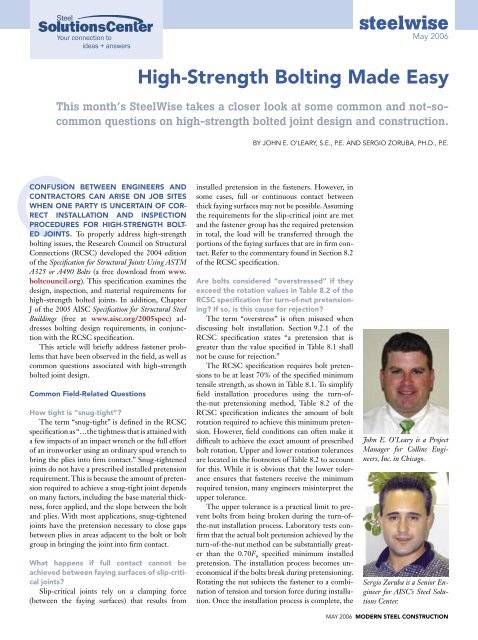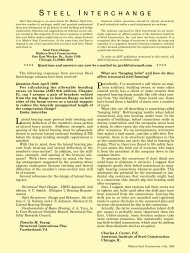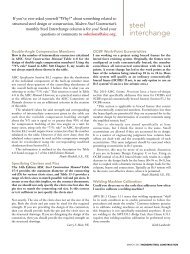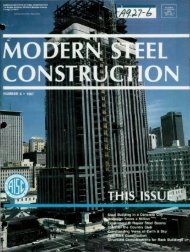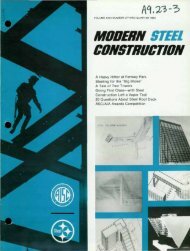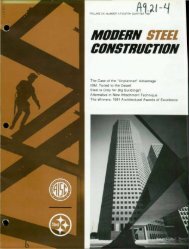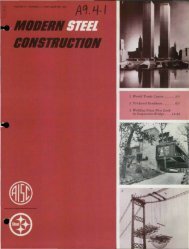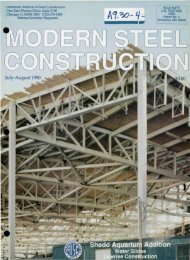High-Strength Bolting Made Easy steelwise - Modern Steel ...
High-Strength Bolting Made Easy steelwise - Modern Steel ...
High-Strength Bolting Made Easy steelwise - Modern Steel ...
Create successful ePaper yourself
Turn your PDF publications into a flip-book with our unique Google optimized e-Paper software.
Your connection to<br />
ideas + answers<br />
CCONFUSION BETWEEN ENGINEERS AND<br />
CONTRACTORS CAN ARISE ON JOB SITES<br />
WHEN ONE PARTY IS UNCERTAIN OF COR-<br />
RECT INSTALLATION AND INSPECTION<br />
PROCEDURES FOR HIGH-STRENGTH BOLT-<br />
ED JOINTS. To properly address high-strength<br />
bolting issues, the Research Council on Structural<br />
Connections (RCSC) developed the 2004 edition<br />
of the Specification for Structural Joints Using ASTM<br />
A325 or A490 Bolts (a free download from www.<br />
boltcouncil.org). This specification examines the<br />
design, inspection, and material requirements for<br />
high-strength bolted joints. In addition, Chapter<br />
J of the 2005 AISC Specification for Structural <strong>Steel</strong><br />
Buildings (free at www.aisc.org/2005spec) addresses<br />
bolting design requirements, in conjunction<br />
with the RCSC specification.<br />
This article will briefly address fastener problems<br />
that have been observed in the field, as well as<br />
common questions associated with high-strength<br />
bolted joint design.<br />
<strong>steelwise</strong><br />
May 2006<br />
<strong>High</strong>-<strong>Strength</strong> <strong>Bolting</strong> <strong>Made</strong> <strong>Easy</strong><br />
This month’s <strong>Steel</strong>Wise takes a closer look at some common and not-socommon<br />
questions on high-strength bolted joint design and construction.<br />
Common Field-Related Questions<br />
How tight is “snug-tight”?<br />
The term “snug-tight” is defined in the RCSC<br />
specification as “…the tightness that is attained with<br />
a few impacts of an impact wrench or the full effort<br />
of an ironworker using an ordinary spud wrench to<br />
bring the plies into firm contact.” Snug-tightened<br />
joints do not have a prescribed installed pretension<br />
requirement. This is because the amount of pretension<br />
required to achieve a snug-tight joint depends<br />
on many factors, including the base material thickness,<br />
force applied, and the slope between the bolt<br />
and plies. With most applications, snug-tightened<br />
joints have the pretension necessary to close gaps<br />
between plies in areas adjacent to the bolt or bolt<br />
group in bringing the joint into firm contact.<br />
What happens if full contact cannot be<br />
achieved between faying surfaces of slip-critical<br />
joints?<br />
Slip-critical joints rely on a clamping force<br />
(between the faying surfaces) that results from<br />
BY JOHN E. O’LEARY, S.E., P.E. AND SERGIO ZORUBA, PH.D., P.E.<br />
installed pretension in the fasteners. However, in<br />
some cases, full or continuous contact between<br />
thick faying surfaces may not be possible. Assuming<br />
the requirements for the slip-critical joint are met<br />
and the fastener group has the required pretension<br />
in total, the load will be transferred through the<br />
portions of the faying surfaces that are in firm contact.<br />
Refer to the commentary found in Section 8.2<br />
of the RCSC specification.<br />
Are bolts considered “overstressed” if they<br />
exceed the rotation values in Table 8.2 of the<br />
RCSC specification for turn-of-nut pretensioning?<br />
If so, is this cause for rejection?<br />
The term “overstress” is often misused when<br />
discussing bolt installation. Section 9.2.1 of the<br />
RCSC specification states “a pretension that is<br />
greater than the value specified in Table 8.1 shall<br />
not be cause for rejection.”<br />
The RCSC specification requires bolt pretensions<br />
to be at least 70% of the specified minimum<br />
tensile strength, as shown in Table 8.1. To simplify<br />
field installation procedures using the turn-ofthe-nut<br />
pretensioning method, Table 8.2 of the<br />
RCSC specification indicates the amount of bolt<br />
rotation required to achieve this minimum pretension.<br />
However, field conditions can often make it<br />
difficult to achieve the exact amount of prescribed<br />
bolt rotation. Upper and lower rotation tolerances<br />
are located in the footnotes of Table 8.2 to account<br />
for this. While it is obvious that the lower tolerance<br />
ensures that fasteners receive the minimum<br />
required tension, many engineers misinterpret the<br />
upper tolerance.<br />
The upper tolerance is a practical limit to prevent<br />
bolts from being broken during the turn-ofthe-nut<br />
installation process. Laboratory tests confirm<br />
that the actual bolt pretension achieved by the<br />
turn-of-the-nut method can be substantially greater<br />
than the 0.70F u specified minimum installed<br />
pretension. The installation process becomes uneconomical<br />
if the bolts break during pretensioning.<br />
Rotating the nut subjects the fastener to a combination<br />
of tension and torsion force during installation.<br />
Once the installation process is complete, the<br />
John E. O’Leary is a Project<br />
Manager for Collins Engineers,<br />
Inc. in Chicago.<br />
Sergio Zoruba is a Senior Engineer<br />
for AISC’s <strong>Steel</strong> Solutions<br />
Center.<br />
MAY 2006 MODERN STEEL CONSTRUCTION
stress in the bolt decreases due to removal<br />
of the torsional force. Therefore, bolts that<br />
do not fail during installation are adequate<br />
for service from an installation perspective.<br />
Rotations greater than those prescribed in<br />
Table 8.2 need not be cause for rejection of<br />
the bolted joint.<br />
Should light surface corrosion or oxidation<br />
be removed from faying surfaces<br />
prior to installing high-strength bolts?<br />
After fabrication, steel members often<br />
sit idle before they are erected. During this<br />
period, light surface corrosion or oxidation<br />
often forms on the surfaces of uncoated<br />
blast-cleaned steel. This surface corrosion<br />
can actually be beneficial to the connection<br />
by increasing the slip resistance of the<br />
joint. In fact, tests have shown that a Class<br />
B slip resistance, which represents the largest<br />
mean slip coefficient of all classes, can<br />
be preserved after one-year of exposure<br />
to normal atmospheric conditions. Refer<br />
to the commentary in Section 3.2.2 in the<br />
2004 RCSC specification.<br />
Can galvanized faying surfaces be<br />
roughened mechanically?<br />
Galvanized faying surfaces must be handroughened<br />
rather than mechanically roughened.<br />
The purpose of roughening the faying<br />
surface is to increase the slip coefficient<br />
between surface plies. Mechanical roughening<br />
can polish the surface (and sometimes<br />
remove the galvanized coating), thereby reducing<br />
the slip resistance. Refer to Section<br />
3.2.2 (c) of the RCSC specification.<br />
Bolted joints with long-slotted holes<br />
require a 5 ⁄16” thick washer or continuous<br />
bar. Can multiple washers be used<br />
if their total thickness is at least 5 ⁄16”?<br />
The use of multiple washers is unacceptable,<br />
as the washer must provide for a<br />
non-galling surface. For pretensioned and<br />
slip-critical joints, the washer must be capable<br />
of transferring bolt pretension over<br />
the slotted holes. As such, the washer must<br />
have adequate stiffness to properly develop<br />
the clamping force. The stacking of washers<br />
does not provide the same stiffness as<br />
a single 5 ⁄16” washer, and thus is not an acceptable<br />
alternative. Refer to Table 6.1 of<br />
the RCSC specification.<br />
Common Design Questions<br />
The bolt holes of a snug-tightened<br />
joint are 1 ⁄16” greater than the stan-<br />
MODERN STEEL CONSTRUCTION MAY 2006<br />
dard hole diameter. Is any corrective<br />
action necessary?<br />
In this case, bolt hole diameter must<br />
be considered oversized if used with the<br />
original bolt diameter. This can be costly<br />
because one would then have to treat the<br />
joint as slip-critical due to the oversized<br />
holes, thereby requiring preparation of all<br />
faying surfaces. A decrease in the available<br />
strength of the bolted joint may also<br />
occur. Therefore, additional bolts may be<br />
required. Alternatively, a larger bolt diameter<br />
can be used and the holes reamed, if<br />
necessary. Note that net sections and other<br />
connection element limit states must be rechecked<br />
for the new hole sizes.<br />
Where are pretensioned or slip-critical<br />
requirements located?<br />
Bolted fastener requirements can be<br />
found in two documents, the RCSC specification,<br />
Sections 4.2 and 4.3, and the AISC<br />
Specification for Structural <strong>Steel</strong> Buildings,<br />
Chapter J. Both specifications can be downloaded<br />
free of charge from www.boltcouncil.org<br />
and www.aisc.org/2005spec,<br />
respectively.<br />
Why aren’t all joints specified as slipcritical?<br />
Slip-critical joints are designed to<br />
transfer loads through a joint without slip<br />
at service loads. However, the fabrication<br />
and preparation of slip-critical joints can<br />
cost three times more than snug-tightened<br />
joints. It is important to realize that slip resistance<br />
may not be required in every joint.<br />
Unnecessary specification of slip-critical<br />
joints is simply a waste of money. Refer to<br />
Section 4 of the 2004 RCSC specification<br />
to determine whether a snug-tightened,<br />
pretensioned, or slip-critical joint is required.<br />
Do I need to design for bearing in slipcritical<br />
joints?<br />
Slip-critical joints must always be designed<br />
for bearing in case the assumed<br />
service loads are exceeded. This requirement,<br />
in both the AISC and RCSC specifications,<br />
ensures that in the event one or<br />
more bolts go into bearing, a block shear<br />
rupture or bearing deformation failure<br />
does not occur.<br />
Are slip-critical joints mandatory for<br />
bolted joints used in Seismic Load Resisting<br />
Systems?<br />
The AISC Seismic Provisions (www.<br />
aisc.org/seismic) require that the joint<br />
be designed as a pretensioned joint, but<br />
prepared as slip-critical (all faying surfaces<br />
must have a Class A or better slip<br />
resistance). The design strength used in<br />
structural calculations is based on bearing<br />
joints rather than the smaller design values<br />
associated with slip-critical joints because<br />
slip at ultimate load generally cannot and<br />
need not be prevented.<br />
Must the installed pretension be added<br />
to the tension or shear load when<br />
designing a bolted joint?<br />
It is important to remember that pretension<br />
(i.e. installation tension) is always<br />
ignored when determining the design<br />
strength of a bolted joint. The initial pretension<br />
is reduced to zero (or near zero) as<br />
a bolt is loaded to failure in shear and/or<br />
tension. This effect is due to the deformations<br />
that occur prior to bolt failure.<br />
As mentioned in commentary Section<br />
5.1 of the RCSC specification “measurements<br />
taken in laboratory tests confirm<br />
that the pretension that would be sustained<br />
if the applied load were removed is essentially<br />
zero before the bolts fails in shear<br />
(Kulak et al., 1987). Thus, the shear and<br />
tensile strengths of a bolt are not affected<br />
by the presence of an initial pretension in<br />
the bolt.”<br />
In the case of a tension connection, the<br />
initial pretension and the external tension<br />
add up to the point of separation of the<br />
connected parts. However, this increase is<br />
relatively small and is customarily ignored,<br />
as it occurs prior to bolt failure.<br />
How much torque is required to<br />
achieve 70% of the specified minimum<br />
tensile strength of a bolt? Is there a<br />
simple equation or table to correlate<br />
installation tension and torque?<br />
There is no recognized quantitative<br />
relationship between torque and pretension<br />
in a bolt. Theoretical relationships<br />
developed for an installation torque versus<br />
installed pretension can be significantly unreliable.<br />
In fact, a variation of as much as<br />
40% can exist between torque and pretension<br />
unless the relationship is established<br />
individually for each bolt lot, diameter, and<br />
fastener condition.<br />
Many factors can greatly influence the<br />
amount of friction in a fastener assembly,<br />
resulting in higher torque values. Such<br />
factors include the finish and tolerance of<br />
threads, the amount or quality of lubrication,<br />
corrosion products, dirt, or dust from<br />
job-site conditions. Besides friction, the<br />
ability of the wrench to provide accurate
and consistent measurements must also be<br />
verified to prevent additional variations.<br />
To ensure there is an accurate correlation<br />
between the torque and tension values, the<br />
RCSC specification contains set calibration<br />
guidelines when using a torque wrench for<br />
pretensioning. Prior to installing fasteners,<br />
each wrench must be calibrated on a daily<br />
basis for individual assembly lots when an<br />
assembly lot is relubricated, when changes<br />
in the fastener surface condition are noted,<br />
and when wrench components are changed.<br />
Use of an uncalibrated wrench is prohibited<br />
due to the large number of variables affecting<br />
torque. A calibrated wrench installation<br />
method can be used as outlined in Section<br />
8.2.2. Other pretensioning methods, such<br />
as turn-of-the-nut, the use of twist-off-type<br />
tension-control bolts, and direct tension<br />
indicators, are discussed in Section 8.2.<br />
What grade of bolt is suitable to replace<br />
a rivet?<br />
Repair or remediation efforts often require<br />
old rivets to be replaced with bolts.<br />
Tests have shown that the strength of some<br />
rivets may exceed that of standard ASTM<br />
A307 bolts. In lieu of testing rivets, ASTM<br />
A325 bolts can be used to prevent any loss<br />
of the joint capacity as long as fatigue issues<br />
have been investigated. Referring to a February<br />
2005 AISC <strong>Steel</strong> Interchange question<br />
(www.aisc.org/steelinterchange) by<br />
Professor Geoff Kulak:<br />
“Whether or not riveted joints are<br />
considered to be slip-critical is an interesting<br />
question, but perhaps only<br />
of academic interest now. In support<br />
of the position that they were slipcritical<br />
is that they were designed<br />
that way when repetitive loads were<br />
present, if only by implication. Putting<br />
it another way, there is a fatigue<br />
category for riveted joints. Are such<br />
joints in bearing or are they slip-critical?<br />
If they are indeed in bearing,<br />
then the fatigue category customarily<br />
selected for this case is significantly<br />
non-conservative. The ‘stress<br />
category’ used in the AISC LRFD<br />
specification (typical) is D. If the<br />
rivets are truly in bearing, the stress<br />
category will be much less than D.<br />
The selection of D comes from test<br />
results and those test results are from<br />
riveted joints that in fact transmit the<br />
load by a combination of friction and<br />
bearing; some rivets are in bearing<br />
and there is enough tensile force in<br />
the rivet to provide slip resistance as<br />
well. By the way, whatever rivet tension<br />
is present arises as the heated<br />
rivet shrinks against the connected<br />
material as cooling takes place.”<br />
If you are looking for information beyond<br />
that provided in this article or in the<br />
AISC and RCSC specifications, look for<br />
AISC’s Design Guide 17—<strong>High</strong> <strong>Strength</strong><br />
Bolts: A Primer for Structural Engineers<br />
(available to purchase at www.aisc.org/<br />
epubs) and RCSC’s Guide to Design Criteria<br />
for Bolted and Riveted Joints (free from<br />
www.boltcouncil.org). AISC’s <strong>Steel</strong> Solutions<br />
Center is always willing to help, as<br />
well, and can provide an answer to your<br />
questions within one business day. Contact<br />
the Solutions Center by phone at 800.ASK.<br />
AISC or by e-mail at solutions@aisc.org.<br />
MAY 2006 MODERN STEEL CONSTRUCTION


